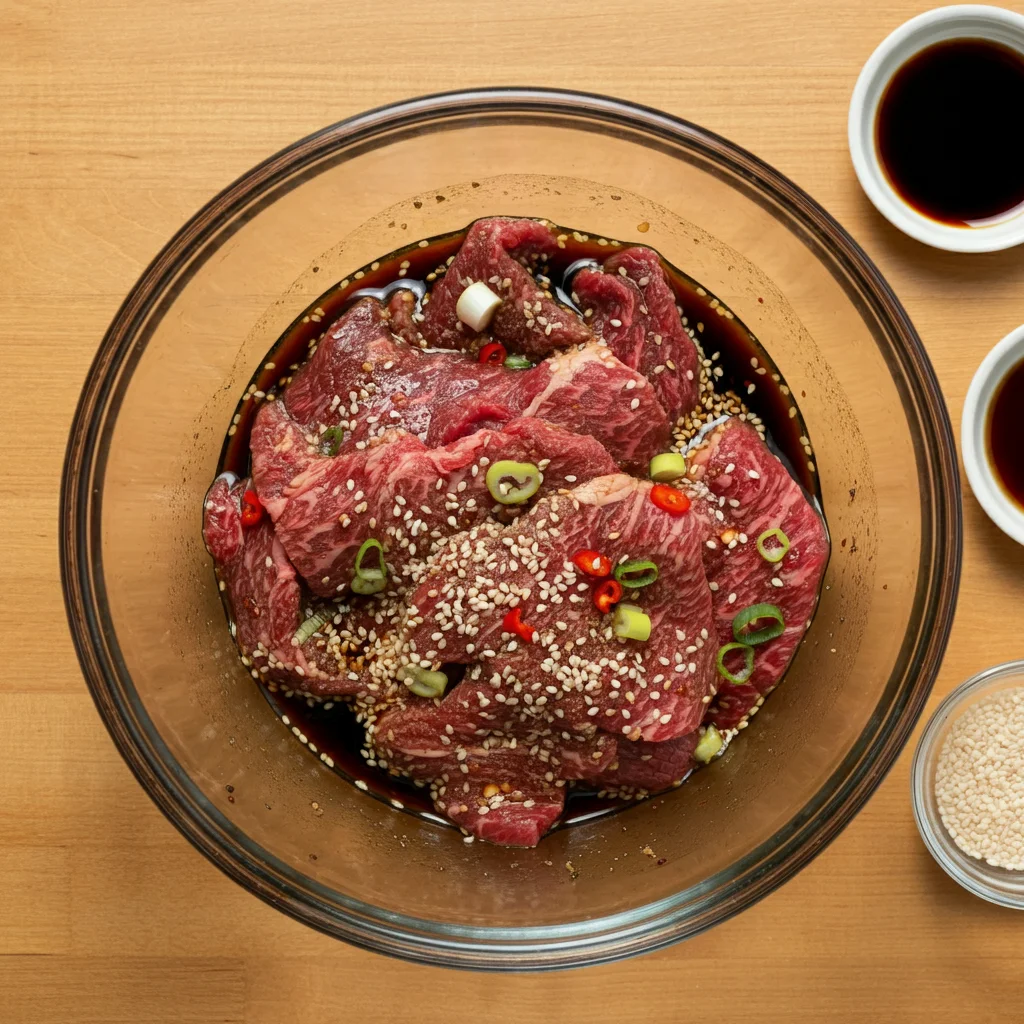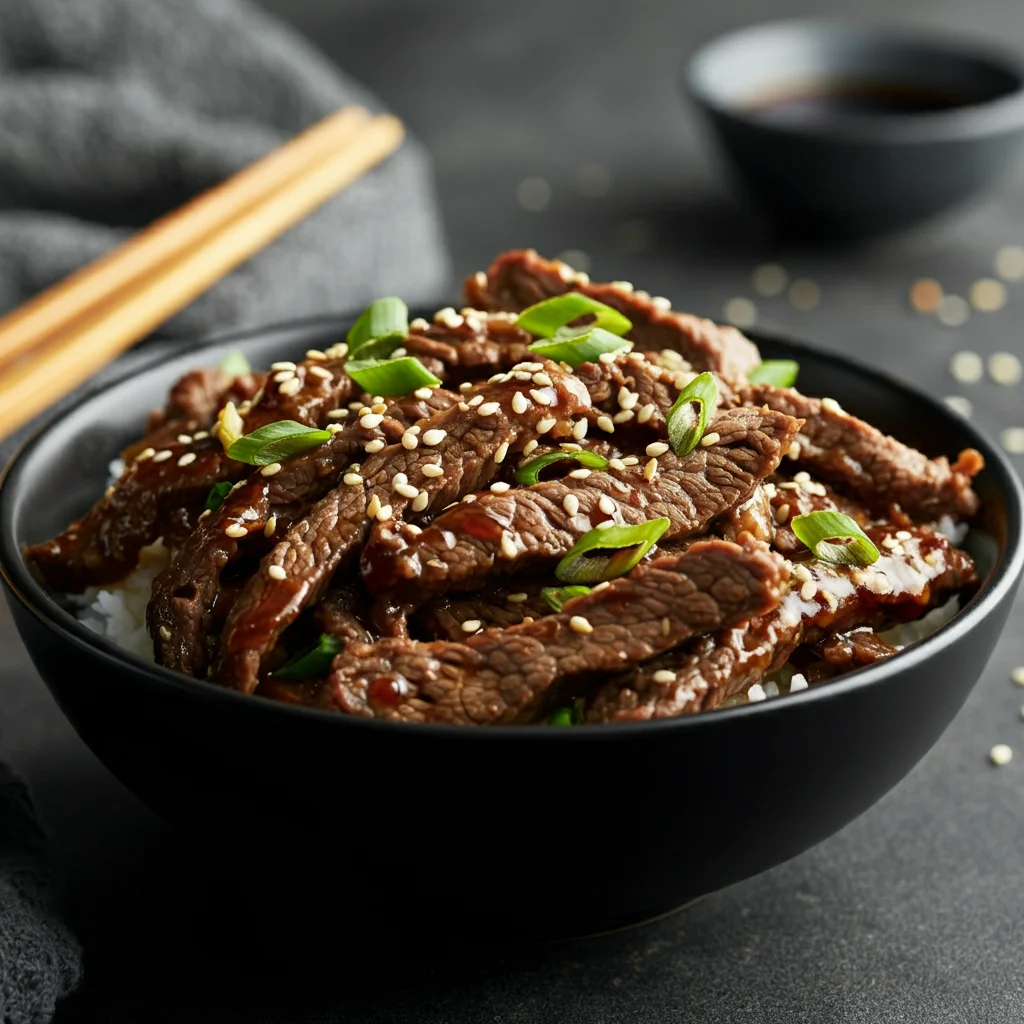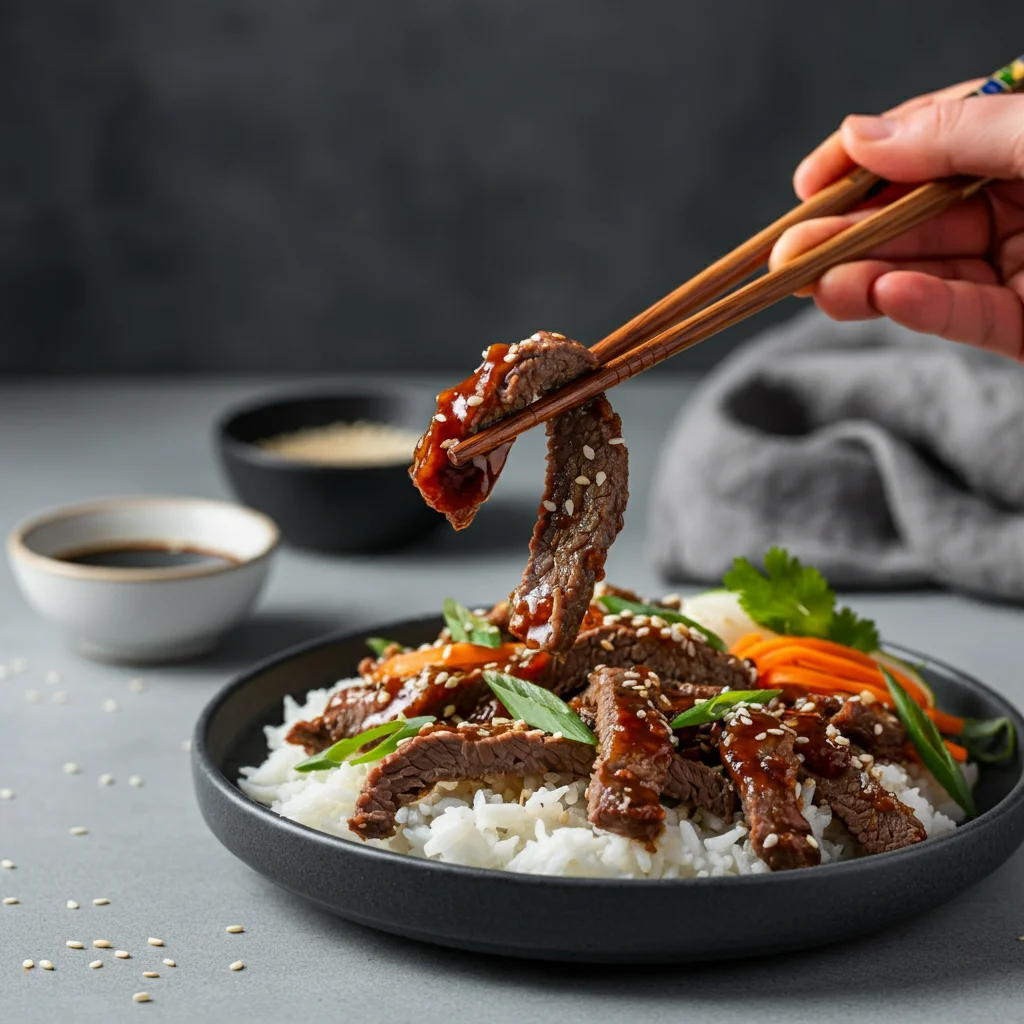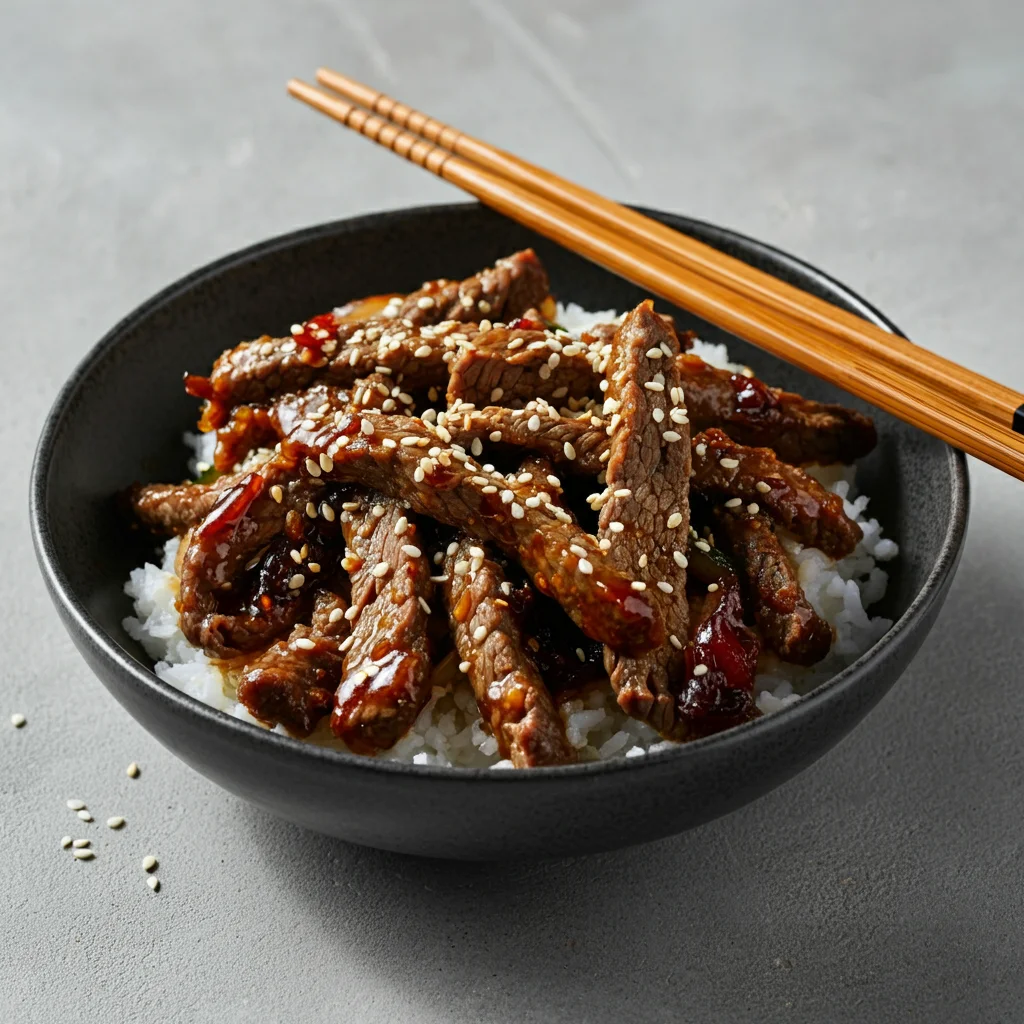Are you craving Korean food but want to stick to your keto diet? This Keto Beef Bulgogi Recipe is here to satisfy those cravings without breaking your carb count.
This dish combines the rich, savory flavors of traditional bulgogi with keto-friendly ingredients, offering a low-carb, gluten-free, and healthy version of a Korean favorite.
Perfect for weeknight dinners or meal prep, this recipe uses thinly sliced beef marinated in a flavorful sauce made from tamari, ginger, and sesame oil. And instead of rice, we’re pairing it with konjac noodles, which are practically zero-carb!
So whether you’re aiming for a keto-friendly, low-carb, or grain-free diet, this Keto Beef Bulgogi Recipe has got you covered.
Table of Contents
| Look at the Recipe (Key Highlights) |
| Ingredients for Keto Cauliflower Pizza Crust |
| How to Make This Healthy Keto Cauliflower Pizza Crust |
| Storage & Serving Suggestions |
| Tips & FAQs |
Look at the Recipe: Key Highlights
- Low-Carb, Keto-Friendly
This recipe swaps out high-carb ingredients like regular soy sauce and sugar for keto-friendly alternatives, keeping your carb intake low without sacrificing flavor. - Tender, Juicy Beef
The trick to achieving restaurant-quality beef bulgogi at home? Thinly slicing the beef and “velveting” it with baking soda, just like they do in professional kitchens. The result is melt-in-your-mouth, tender beef. - Authentic Bulgogi Sauce
Made with tamari, ginger, garlic, sesame oil, and grated pear, this sauce gives you that authentic bulgogi flavor but keeps it keto with monk fruit sweetener. - Konjac Noodles: The Perfect Substitute
Instead of traditional rice or noodles, we use konjac noodles, which are low-carb and zero-calorie, making them perfect for a keto lifestyle. - Packed with Flavor & Nutrition
This recipe includes sautéed spinach and garlic for extra nutrients and flavor, making it a well-rounded, satisfying dish that’s perfect for lunch or dinner. - Flexible Serving Options
Serve the beef bulgogi over konjac noodles for a filling meal or use lettuce wraps for a lighter, low-carb alternative. Add kimchi or fermented vegetables for an authentic Korean touch.
Ingredients Needed:

For the Bulgogi Sauce:
- Tamari
- Red pepper flakes
- Fresh ginger, grated
- Monk fruit brown sugar
- Sesame oil
- Ripe pear, grated
- Gochujang sauce
For the Beef Bulgogi:
- Skirt steak (or preferred cut)
- Baking soda (for tenderizing)
- Bulgogi sauce (from above)
- Avocado oil
- Green onions, sliced thin
- Sea salt
- Freshly ground black pepper
For Serving:
- Fresh spinach
- Garlic, minced
- Konjac noodles
- Lettuce leaves (optional)
- Fermented carrots (optional)
- Kimchi (optional)
- Extra gochujang (optional)
How to Make Keto Beef Bulgogi
Prepare the Beef: Start by partially freezing the beef to make slicing easier. After slicing, coat the beef with baking soda and allow it to sit, which will help tenderize it.
Make the Bulgogi Sauce: While the beef rests, mix up the bulgogi sauce by combining tamari, red pepper flakes, grated ginger, monk fruit, sesame oil, grated pear, and gochujang.
Marinate the Beef: Rinse the baking soda off the beef, dry it, and marinate it with the bulgogi sauce, avocado oil, green onions, and seasoning.
Cook the Beef: Quickly sear the beef in a hot skillet for a couple of minutes until browned. Let it rest before serving.
Saute the Veggies: In the same skillet, sauté the spinach and garlic, followed by warming the konjac noodles.
Serve: Layer the noodles, spinach, and beef, garnishing with optional toppings like kimchi, lettuce leaves, or fermented carrots.

Storage and Serving Suggestions for Keto Beef Bulgogi
Storage Suggestions:
- Refrigeration: If you have leftovers (though that’s rare with this delicious dish!), you can store the Keto Beef Bulgogi in an airtight container in the fridge for up to 3-4 days. Be sure to store the beef, spinach, and konjac noodles separately, if possible, to preserve the texture of each component. This way, you can reheat and enjoy without the noodles or spinach becoming too soggy.
- Freezing: You can also freeze the cooked beef bulgogi for longer storage. Once cooled, place the bulgogi in a freezer-safe container or a zip-top bag and freeze for up to 2-3 months. When freezing, make sure to portion the beef out into smaller batches for easy reheating. Avoid freezing the spinach and konjac noodles as they tend to lose texture after thawing.
- Reheating:
- Refrigerated Beef Bulgogi: Reheat in a skillet over medium heat with a little bit of oil until the beef is warmed through. You can also microwave it, but the skillet method keeps the beef tender and flavorful.
- Frozen Beef Bulgogi: Thaw the beef in the fridge overnight before reheating. Once thawed, reheat in a skillet with a small amount of oil for the best texture and flavor.
Serving Suggestions:
- Over Konjac Noodles:
For a filling and low-carb option, serve the bulgogi beef over konjac noodles (as in the original recipe). Konjac noodles are a great keto alternative to rice or traditional noodles, keeping the carbs low while offering a satisfying texture. - Lettuce Wraps:
If you’re in the mood for something lighter or handheld, serve the bulgogi in lettuce wraps. Butter lettuce or romaine lettuce leaves work well for wrapping the beef bulgogi. Add kimchi, fermented carrots, or even a bit of gochujang for extra flavor. - Side of Vegetables:
For a nutrient-dense meal, pair the bulgogi with sautéed vegetables like zucchini noodles (zoodles), cauliflower rice, or broccoli. You can also add grilled mushrooms, bell peppers, or a simple salad for added fiber and flavor. - Korean Toppings:
Add some fermented carrots, kimchi, or pickled cucumbers on the side for a more traditional Korean touch. These condiments bring an authentic flavor and enhance the low-carb, gut-friendly benefits of the dish. - Spicy Gochujang Drizzle:
If you can handle a little extra heat, serve the bulgogi with a drizzle of gochujang or a sprinkle of red pepper flakes to spice things up. Keep in mind that gochujang contains some carbs, so use sparingly if you’re counting every carb.
By adjusting how you serve it, you can enjoy Keto Beef Bulgogi in various ways, making this a versatile and repeatable meal that never gets boring.
Frequently Asked Questions (FAQs)
Can I substitute the skirt steak with another cut of beef?
Absolutely! Flank steak or ribeye work just as well and still maintain that tender, flavorful bite.
Is gochujang keto-friendly?
Gochujang does contain a bit of sugar, but used sparingly, it won’t significantly impact your carb count. If you’re strict keto, you can skip it or substitute it with more red pepper flakes or a keto-friendly chili paste.
What are konjac noodles?
Konjac noodles, also known as shirataki noodles, are a keto favorite because they are low in carbs and calories. Just make sure to rinse them well before using to eliminate their natural odor.
Can I make this dish ahead of time?
Yes! You can marinate the beef up to 24 hours in advance. Simply cook everything when you’re ready to serve, making it a great dish for meal prep.
What can I use if I don’t have monk fruit sweetener?
You can substitute monk fruit with erythritol or stevia, just adjust the amount according to taste.
Is this dish freezer-friendly?
Not the best for freezing, as cooked beef can become tough, and the texture of the spinach and noodles may change. It’s best enjoyed fresh or kept in the fridge for up to 3 days.
Conclusion: Why Keto Beef Bulgogi Should Be Your Go-To Low-Carb Meal
This Keto Beef Bulgogi recipe is the perfect balance of flavor, nutrition, and ease. Whether you’re craving the bold, savory flavors of Korean BBQ or looking for a low-carb, high-protein meal, this dish delivers on all fronts. The marinated, tender beef paired with nutrient-packed spinach and konjac noodles makes it an ideal meal for lunch or dinner that won’t throw off your keto goals.
The best part? It’s versatile! You can enjoy this bulgogi over konjac noodles, in lettuce wraps, or even with a side of kimchi for an authentic Korean touch. Plus, you can make extra bulgogi sauce and store it in the fridge, making it easy to recreate this dish whenever the craving strikes.
So, next time you’re in the mood for something delicious, filling, and low-carb, give this Keto Beef Bulgogi a try. It’s a flavorful way to enjoy Korean BBQ, all while staying on track with your keto lifestyle.



